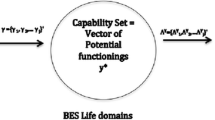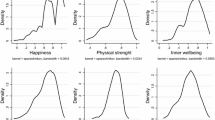Abstract
Sen’s Capability Approach is one of the most significant theoretical contributions to welfare analysis across a range of disciplines. A part of the literature argues that its conceptual linear flow—from resources to ‘functionings’, which result in well-being—potentially ignores more complex relations with the feedback loops where a single item could be viewed as having a different role by different people, in different contexts. We explore perceptions of existing feedback relationships in interviews with 74 women from nine seaweed farming villages in Indonesia, engaged in two distinct activities: seaweed farming and artisanal seaweed processing. We find that capability sets required for farming and for processing are distinct and in both cases we observe feedback loops. Several factors, notably social networks and transportation (motorbikes), were mentioned in almost all contexts indicating that not all resources are of equal ‘value’ and might yield different levels of well-being.



Similar content being viewed by others
References
Addison, J., N. Stoeckl, S. Larson, D. Jarvis, Bidan Aboriginal Corporation, Bunuba Dawangarri Aboriginal Corporation RNTBC, Ewamian Aboriginal Corporation RNTBC, Gooniyandi Aboriginal Corporation RNTBC, et al. 2019. The ability of community based natural resource management to contribute to development as freedom and the role of access. World Development 120: 91–104.
Anand, P., G. Hunter, I. Carter, K. Dowding, F. Guala, and M. Van Hees. 2009. The development of capability indicators. Journal of Human Development and Capabilities 10: 125–152.
Anand, P., G. Hunter, and R. Smith. 2005. Capabilities and wellbeing: Evidence based on the Sen–Nussbaum approach to welfare. Social Indicators Research 74: 9–55. https://doi.org/10.1007/s11205-005-6518-z.
Binder, M. 2014. Subjective wellbeing capabilities: Bridging the gap between the capability approach and subjective wellbeing research. Journal of Happiness Studies 15: 1197–1217. https://doi.org/10.1007/s10902-013-9471-6.
Binder, M., and A. Coad. 2011. Disentangling the circularity in Sen’s capability approach—An analysis of the co-evolution of functioning achievement and resources. Social Indicators Research 103: 327–355.
Buku Statistik Perikanan Budidaya—Book of aquaculutre statistics, 2018. Indonesia 2017. https://www.bps.go.id/subject/56/perikanan.html. Accessed 12 June 2020.
Dambacher, J., P. Rothlisberg, and N. Loneragan. 2015. Qualitative mathematical models to support ecosystem-based management of Australia’s Northern Prawn Fishery. Ecological Applications 25: 278–298. https://doi.org/10.1890/13-2030.1.
Daw, T.M., C. Hicks, K. Brown, T. Chaigneau, F. Januchowski-Hartley, W. Cheung, S. Rosendo, B. Crona, et al. 2016. Elasticity in ecosystem services: Exploring the variable relationship between ecosystems and human well-being. Ecology and Society 21: 11. https://doi.org/10.5751/ES-08173-210211.
Eklöf, J.S., R. Henriksson, and N. Kautsky. 2006. Effects of tropical open-water seaweed farming on seagrass ecosystem structure and function. Marine Ecology Progress Series 325: 73–84.
Food and Agriculture Organisation (FAO). 2019. FAO Yearbook 2017: Fisheries and Aquaculture Statistics. Rome: FAO.
FAO. 2017. Women’s empowerment in aquaculture in Bangladesh and Indonesia: Insights from four case studies. Rome: FAO.
FAO. 2014. Youth and agriculture: Key challenges and concrete solutions. Rome: FAO.
Fröcklin, S., M. de la Torre-Castro, L. Lindström, N.S. Jiddawi, F.E. Msuya. 2012. Seaweed mariculture as a development project in Zanzibar, East Africa: A price too high to pay? Aquaculture 356: 30–39.
Iversen, V. 2003. Intra-household inequality: A challenge for the Capability Approach? Feminist Economics 9: 93–115.
Kelly, E., A.L. Cannon, and J.E. Smith. 2020. Environmental impacts and implications of tropical carrageenophyte seaweed farming. Conservation Biology 34: 326–337.
Krishnakumar, J. 2007. Going beyond functionings to capabilities: An econometric model to explain and estimate capabilities. Journal of Human Development 8: 39–63.
Larson, S., N. Stoeckl, M.E. Fachry, M. Dalvi Mustafa, I. Lapong, A.H. Purnomo, M. Rimmer, and N.A. Paul. 2021. Women’s wellbeing and household benefits from seaweed farming in Indonesia. Aquaculture 530: 735711.
Larson, S., N. Stoeckl, D. Jarvis, J. Addison, S. Prior, and M. Esparon. 2019. Using measures of wellbeing for impact evaluation: Proof of concept from a case study with an Indigenous community in North Queensland, Australia. Ambio 48: 89–98. https://doi.org/10.1007/s13280-018-1058-3.
Larson, S. 2011. From individual wellbeing to regional priorities: Concepts and measures to assist policy makers. Newcastle upon Tyne: Cambridge Scholars Publishing.
Marino, M., A. Breckwoldt, M. Teichberg, A. Kase, and H. Reuter. 2019. Livelihood aspects of seaweed farming in Rote Island, Indonesia. Marine Policy. https://doi.org/10.1016/j.marpol.2019.103600.
Martinetti, E.C. 2000. A multidimensional assessment of wellbeing based on Sen’s functioning approach. Revista Internazionale di Scienze Social 108: 207–239.
Neish, I.C. 2013. Social and economic dimensions of carrageenan seaweed farming in Indonesia. In Social and economic dimensions of carrageenan seaweed farming. Fisheries and Aquaculture Technical Paper No. 580, eds. D. Valderrama, J. Cai, N. Hishamunda and N. Ridler, 61–89. Rome: FAO.
Nussbaum, M.C. 2000. Women and human development—The capabilities approach. Cambridge: Cambridge University Press.
Ramos, X., and J. Silber. 2005. On the application of efficiency analysis to the study of the dimensions of human development. Review of Income and Wealth 51: 285–309.
Robeyns, I. 2006. The capability approach in practice. The Journal of Political Philosophy 14: 351–376.
Robeyns, I. 2005. The capability approach: A theoretical survey. Journal of Human Development 6: 93–114.
Robeyns, I. 2003. Sen’s capability approach and gender inequality: Selecting relevant capabilities. Feminist Economics 9: 61–92.
Sen, A.K. 1999. Development as freedom. New York: Anchor Books.
Sen, A.K. 1984. Resources, values and development. Cambridge: Harvard University Press.
Sen, A.K. 1979. Personal utilities and public judgements, or what’s wrong with welfare economics? Economic Journal 89: 537–558.
Stern, E., N. Stame, J. Mayne, K. Forss, R. Davies, and B. Befani. 2012. Broadening the range of designs and methods for impact evaluations. Working Paper 38. London: Department for International Development (DIFD).
Stoeckl, N., C. Hicks, M. Farr, D. Grainger, M. Esparon, J. Thomas, and S. Larson. 2018. The crowding out of complex social goods. Ecological Economics 144: 65–72.
Valderrama, D., J. Cai, N. Hishamunda, N. Ridler, I.C. Neish, A.Q. Hurtado, F.E. Msuya, M. Krishnan, et al. 2015. The economics of Kappaphycus seaweed cultivation in developing countries: A comparative analysis of farming systems. Aquaculture Economics and Management 19: 251–277.
van Es, M., I. Guijt, and I. Vogel. 2015. Theory of Change thinking in practice. The Hague: Hivos. http://www.theoryofchange.nl/sites/default/files/resource/hivos_toc_guidelines_final_nov_2015.pdf. Accessed 17 Jan 2016
Wells, T. n.d. Sen’s capability Approach. https://www.iep.utm.edu/sen-cap/. Accessed 4 May 2020.
Acknowledgements
We are grateful to the Australian Centre for International Agricultural Research (ACIAR), The University of Sunshine Coast (Australia), Hasanuddin University (UNHAS, Indonesia) and the University of Tasmania (Australia) for their institutional support. Our special thanks go to our enumerator team led by Dr. Mardiana Fachri and Mr. Dalvi Mustafa and to Mr. Nur Syamsul for creating map in Fig. 1. This research would not be possible without leaders and members of the women’s groups generously donating their time to assist with our enquiries. We thank all three reviewers for their constructive comments which helped us improve this manuscript.
Funding
This work was supported by the Australian Centre for International Agricultural Research (ACIAR) Project No. FIS/2015/038: “Improving seaweed production and processing opportunities in Indonesia”.
Author information
Authors and Affiliations
Contributions
SL: Conceptualization, Methodology, Investigation, Formal analysis, Data curation and Writing-Original draft preparation. NS: Conceptualization, Methodology, Validation and Writing-Original draft preparation. MAR: Supervision and Writing-Review and editing. NAP: Supervision, Writing-Review and editing and Project administration.
Corresponding author
Ethics declarations
Ethical approval
The University of Sunshine Coast Human Ethics Committee Approval Number A/17/997.
Additional information
Publisher's Note
Springer Nature remains neutral with regard to jurisdictional claims in published maps and institutional affiliations.
Rights and permissions
About this article
Cite this article
Larson, S., Stoeckl, N., Rimmer, M.A. et al. Understanding feedback relationships between resources, functionings and well-being: A case study of seaweed farming and artisanal processing in Indonesia. Ambio 51, 914–925 (2022). https://doi.org/10.1007/s13280-021-01581-3
Received:
Revised:
Accepted:
Published:
Issue Date:
DOI: https://doi.org/10.1007/s13280-021-01581-3




